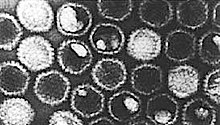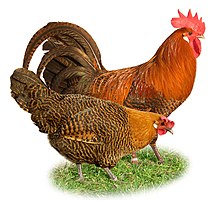Gallid alphaherpesvirus 1
| Gallid alphaherpesvirus 1 | |
|---|---|

| |
| Transmission electron micrograph of virions | |
| Virus classification | |
| (unranked): | Virus |
| Realm: | Duplodnaviria |
| Kingdom: | Heunggongvirae
|
| Phylum: | Peploviricota |
| Class: | Herviviricetes |
| Order: | Herpesvirales |
| Family: | Orthoherpesviridae
|
| Genus: | Iltovirus |
| Species: | Gallid alphaherpesvirus 1
|
| Synonyms | |
| |
| NCBI genome ID | NC_006623 |
|---|---|
| Genome size | 148,687 nucleotides |
| Year of completion | 2005[1] |
Gallid alphaherpesvirus 1 (GaHV-1) is a species of virus in the order
Taxonomy
Gallid alphaherpesvirus 1 is classified in the genus Iltovirus. The only other species in this genus, and therefore its closest known relative, is
There are two other herpesviruses that affect chickens:
Pathology
Transmission
GaHV-1 is shed in respiratory secretions and transmitted by droplet inhalation or via fomites. A previously unexposed flock will develop cases for two to eight weeks following introduction. The incubation period is two to eight days.[3]
Clinical signs and diagnosis

Symptoms include coughing, sneezing, head shaking, lethargy, discharge from the eyes and nostrils (sometimes bloody), and difficulty breathing. The name comes from the severe inflammation of the
Histopathology, PCR, ELISA, immunofluorescent staining, and viral isolation are all possible methods of diagnosis.
Treatment and control
A vaccine is available (
A confirmed case will usually result in the establishment of a
References
- ^ Thureen and Keeler (2005). "Gallid herpesvirus 1, complete genome". National Center for Biotechnology Information. Retrieved 7 January 2019.
- ^ a b c "Virus Taxonomy: 2020 Release". International Committee on Taxonomy of Viruses (ICTV). March 2021. Retrieved 10 May 2021.
- ^ ISBN 0-12-253056-X.
- ^ a b Carter, G.R.; Flores, E.F.; Wise, D.J. (2006). "Herpesviridae". A Concise Review of Veterinary Virology. Retrieved 2006-06-10.
Further reading
- Coppo, Hartley, Devlin (2013). "Immune responses to infectious laryngotracheitis virus". Developmental and Comparative Immunology. 41 (3): 454–462. PMID 23567343.)
{{cite journal}}: CS1 maint: multiple names: authors list (link - Devlin, Browning, Gilkerson (2006). "A glycoprotein I- and glycoprotein E-deficient mutant of infectious laryngotracheitis virus exhibits impaired cell-to-cell spread in cultured cells". Archives of Virology. 151 (7): 1281–1289. S2CID 1699293.)
{{cite journal}}: CS1 maint: multiple names: authors list (link - Devlin, Browning, Hartley, Kikpatrick, Mahmoudian, Noormohammadi, Gilkerson (2006). "Glycoprotein G is a virulence factor in infectious laryngotracheitis virus". Journal of General Virology. 87 (10): 2839–2847. PMID 16963741.)
{{cite journal}}: CS1 maint: multiple names: authors list (link - Loncoman, Hartley, Coppo, Browning, Beltran, Riblet, Freitas, Gracia, Devlin (2018). "Single Nucleotide Polymorphism Genotyping Analysis Shows That Vaccination Can Limit the Number and Diversity of Recombinant Progeny of Infectious Laryngotracheitis Viruses from the United States". Applied and Environmental Microbiology. 84 (23). PMID 30242009.)
{{cite journal}}: CS1 maint: multiple names: authors list (link - Loncoman, Hartley, Coppo, Browning, Quinteros, Diaz-Mendez, Thilakarathne, Fakhri, Vaz, Devlin (2018). "Replication-independent reduction in the number and diversity of recombinant progeny viruses in chickens vaccinated with an attenuated infectious laryngotracheitis vaccine". Vaccine. 36 (38): 5709–5716. S2CID 51972915.)
{{cite journal}}: CS1 maint: multiple names: authors list (link - Loncoman, Hartley, Coppo, Vaz, Diaz-Mendez, Browning, Garcia, Spatz, Devlin (2017). "Genetic Diversity of Infectious Laryngotracheitis Virus during In Vivo Coinfection Parallels Viral Replication and Arises from Recombination Hot Spots within the Genome". Applied and Environmental Microbiology. 83 (23). PMID 28939604.)
{{cite journal}}: CS1 maint: multiple names: authors list (link - Loncoman, Hartley, Coppo, Vaz, Diaz-Mendez, Browning, Lee, Devlin (2017). "Development and application of a TaqMan single nucleotide polymorphism genotyping assay to study infectious laryngotracheitis virus recombination in the natural host". PLOS ONE. 12 (3): e0174590. PMID 28350819.)
{{cite journal}}: CS1 maint: multiple names: authors list (link - Morales Ruiz, Bendezu Eguis, Montesinos, Tataje-Lavanda, Fernandez-Diaz (2018). "Full-Genome Sequence of Infectious Laryngotracheitis Virus (Gallid Alphaherpesvirus 1) Strain VFAR-043, Isolated in Peru". Microbiology Resource Announcements. 6 (10). PMID 29519822.)
{{cite journal}}: CS1 maint: multiple names: authors list (link
External links
- Avian infectious laryngotracheitis, expert reviewed and published by WikiVet, accessed 07/10/2011
- Virus Pathogen Database and Analysis Resource (ViPR): Herpesviridae
